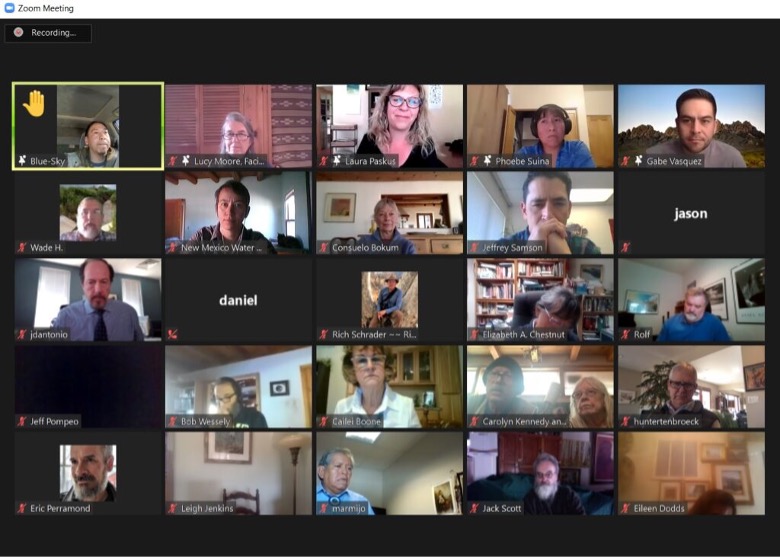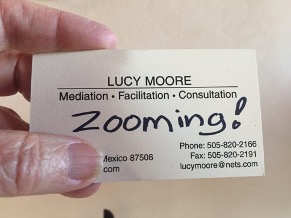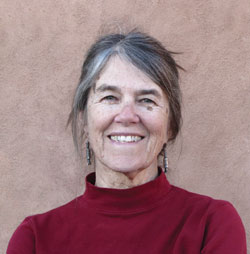By Lucy Moore
This post originally appeared on Lucy Moore Blog on March 31, 2021. We are reposting it with the Lucy Moore’s permission.
I hear zoom complaints every day. “I cannot stand one more zoom call.” “I am zoomed out.” “I will be so happy to get back to work in person.” Yes, you’ve probably heard them, too. In fact you may be one of them. Well, here’s where we part company, because (drum roll) I love zoom!
What’s not to love? You barely have to get dressed. All that counts is from the chest up. A nice top, shirt, maybe a scarf, earrings and I’m set. I have a beautiful cashmere sweater, blue-green, that the moths loved as much as I did. But, lucky me, the holes are in the back, so it is now my zoom uniform…zoomiform.
As I have written in an earlier post, I wear hearing aids, which of course help, but fall short when it comes to mumbling, the soft talker who always sits in the back, people talking over each other, or that wonderful punch line that everyone is hooting about except you. On zoom, I am like my old hearing self. All the voices come in strong and clear, and in a pinch I can read lips because the faces are all close-ups facing me.
Get notified when new articles are posted to the EDR blog – sign up for our email list »
Many of my clients – agencies, organizations, companies – have figured out that they can get more accomplished, and usually cheaper, on zoom. I have more work than I can handle, all of it really interesting and worthwhile, including projects that were languishing because it was so hard to bring people together in person. There were so many challenges: finding a venue for a meeting, finding a date that worked for everyone, flights and hotels, food, audio-visual and tech support for the presentations, transportation for field trips and more. It’s a wonder we ever got anything done. Now, with most people at home sitting in front of the computer anyway, it’s not that hard to find meeting dates and times. Panelists and presenters are sitting around waiting to be asked. And the luncheon fare is do-it-yourself. As for the tech support, careers are being built on zoom-proficiency. There are fabulous young people ready to put the event together with recording, presentations, videos, music, breakout rooms, polling, chatting, all kinds of bells and whistles.
All this is compelling, but let me tell you why I really love zoom. As a facilitator and mediator, I am constantly trying to balance power at the table. I’m speaking of the real table with real people around it. Tables in past projects would have included some formidable power players – maybe a CEO, an aggressive attorney, a philanthropist, an elected official, a professor, a large landowner, a renowned scientist, someone from the media. Of course I am stereotyping to make a point, but these people often ooze power when they walk in the room. It’s not their fault. Our culture and our system honor and elevate certain kinds of power. We all feel it, we know it in our bones. Others at my table may be community members, those for whom English is a second language, those with less education, students, elders, all the rest of us without those attributes of power. Dealing with all these energies in the flesh can be challenging when all I want to do is create a space that is dedicated to productive, respectful conversation and thoughtful, fair decision-making. So I balance power as best I can. I may provide interpretation, tutoring in a technical subject, money for transportation or child care to those who need it in order to participate fully and effectively. I may make time and space for building relationships, sharing values, even telling stories. All this with the goal of achieving equality at the table.

But, if we are on zoom, abracadabra! We are all in our little boxes, each box the same size as all the others. Those oversized personalities, those wielders of power have no more territory than the grandmother from the nearby village. Looking at them all, my participants, lined up makes my heart sing. Zoom has reduced – or elevated – us all to the same plane. My job is not over, of course. There will be power plays and intimidating talk, raised voices and aggressive gestures, beads of sweat, deep sighs of frustration. But all that will happen in the confines of the two- or three-inch-square box. We will all arrive on the screen as equals. There will be no swaggering into the room, setting a pricey briefcase on the table, leaning back in the chair, gazing around the table, choosing someone to chat with that will enhance your power. Efforts at intimidation, conscious or subconscious, fall flat. The grandma, the CEO, there they are side by side, same size heads, each important in their presence and what they have to offer. I find it so refreshing, and my job becomes much easier.
Zoom events also enable people to participate who ordinarily couldn’t afford the cost or wouldn’t have been invited. This includes the huge number of webinars, courses, trainings, and entertainment that is available online. But it also includes the kind of work I do, bringing together the full diversity of people who have a stake in some issue or conflict. The challenge is always how to bring to that real-life table those who are representing an interest that deserves to be part of the dialogue and decision. It may be a tribal leader, a farmer, a community member, a social justice advocate, any of dozens of groups that we recognize as needing a seat at the table if we are to achieve the kind of balanced and just society we aim for. Traveling to a site for a gathering is a big undertaking, and I have seen many budgets unable – and clients unwilling — to support the participation of those who should be there. They become the casualties of a system that prioritizes them last. But lo and behold, zoom welcomes them into the fold! All we need is more boxes. We can even offer those voices a greater role, as a presenters or a panelists, bringing their message to the group with added strength. And critically, we can include more than the token person that might have been invited to the in-person event, allowing the sponsors to “check the diversity box.” With no travel costs, no strain to the budget, there is no limit to the numbers who can join the conversation.
So, as zoom wanes and in-person returns I will not be celebrating. Rather I will be hanging on to my screen, the great equalizer, pleading with clients to “zoom it” just one more time. There is a lot of talk in the field about hybridizing the public involvement and stakeholder processes, with some in person and some on the screen. I’m not sure how that will work, but I fear that those in-person folks will make a power grab. If they try, I will be there to defend and advocate for my participants in their boxes and make sure that the balance and equality is honored. In the meantime, all I know is that I love zoom.

 Based in Santa Fe, New Mexico, Lucy Moore is an environmental mediator, helping adversaries find solutions (or not) to thorny natural resource disputes around water rights, forest management, endangered species, tribal sovereignty, toxic waste storage and more. “Common Ground on Hostile Turf: Stories from an Environmental Mediator” (Island Press 2013) includes stories from her twenty-five year practice that have been significant in her understanding of the issues and of people in conflict. She is also author of “Into the Canyon: Seven Years in Navajo Country,” (University of New Mexico Press, 2004).
Based in Santa Fe, New Mexico, Lucy Moore is an environmental mediator, helping adversaries find solutions (or not) to thorny natural resource disputes around water rights, forest management, endangered species, tribal sovereignty, toxic waste storage and more. “Common Ground on Hostile Turf: Stories from an Environmental Mediator” (Island Press 2013) includes stories from her twenty-five year practice that have been significant in her understanding of the issues and of people in conflict. She is also author of “Into the Canyon: Seven Years in Navajo Country,” (University of New Mexico Press, 2004).
